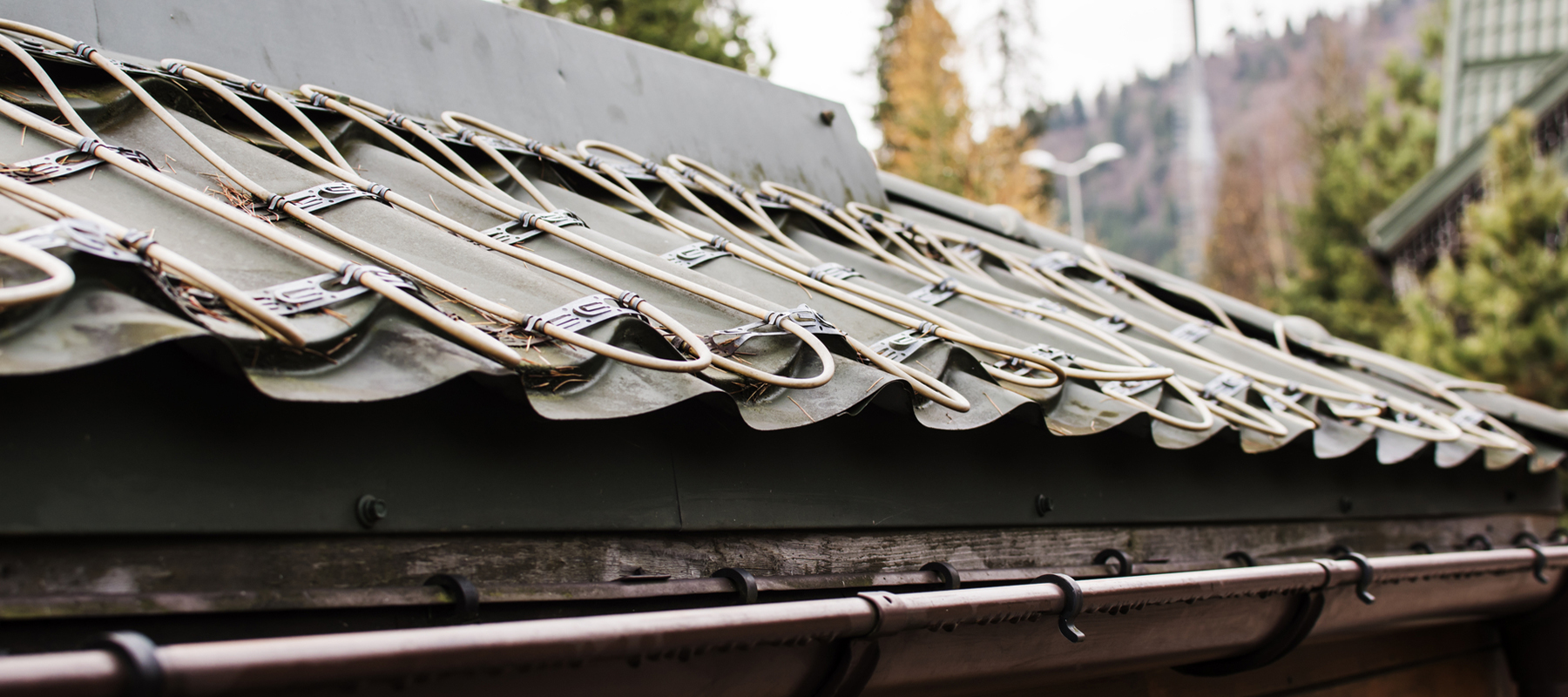Costs for Roof Heating Cable Installation, Materials & Electricity Usage
Last Updated: October 02, 2023

Fact Checked By: Ryan Maguire
On This Page
When snow begins to melt on the roof due to escaping heat from the attic, it often refreezes upon reaching the eaves, which are cooler than the rest of the roof. Ice accumulation on the eaves eventually results in an "ice dam" that can deform roofing and gutters and cause meltwater to pool behind the dam.
The possible consequences of this backed up water include not only roof damage, but also exterior and interior wall, ceiling, floor, and insulation damage.
One way to prevent ice dams is to install roof heating cables, also known as deicing cables or roof heat tape. They're relatively inexpensive to install, especially compared to the cost of cleaning up the destruction wrought by ice and water.
Roof Heating Cable Average Costs #
The roof heating system itself costs $200 to $800 depending on the coverage area needed and type of heating cables used.
Basic Installation Costs:
- Heating cable: $1 - $5 per linear foot
- Thermostat controller: $100 - $200
- Electrical wiring: $2 - $4 per linear foot
- Clips/fasteners: $0.50 - $1 per clip
- Labor: $50 - $100 per hour
For a simple ranch-style home roof of 1,500 sq ft:
- Heating cable for eaves/overhangs: $400
- Controller and wiring: $350
- Clips and fasteners: $200
- Labor: $500
- Total cost: $1,450
On a larger two-story home of 3,000 sq ft:
- Cable for roof perimeter and valleys: $1,200
- Controller, wiring, conduit: $800
- Clips and attachments: $400
- Labor: $1,000
- Total cost: $3,400
Added costs:
- Removal of old roofing materials if a re-roof: $2,000 - $4,000
- Specialty non-penetrating mounting clips: $2 - $4 per clip
- Improved insulation for better efficiency: $1,500 - $3,000
The total costs for professionally installing an electric roof heating system typically ranges from $1,500 to $5,000+ depending on the roof size, layout, and complexity. DIY installation can save on labor but has risks.
Roof Heating Cable Installation Cost Examples #
A homeowner in Minnesota paid $1,850 to have roof heating cable installed on their 1,500 sq ft ranch-style home. This included 350 linear feet of self-regulating cable on the roof edges and downspouts, a controller, wiring, and clips to attach the cable.
A person in Maine was charged $2,750 for installation of an electric heating cable system on their 2-story colonial house. 500 linear feet of cable was installed around the roof perimeter and in the gutters. The job also included a new controller, wiring, and non-penetrating mounting clips.
A contractor in Colorado installed roof heating cables for a client's exposed roof deck area of 800 sq ft. The cables and installation along the deck edges and down the columns cost the customer $1,100 total.
A hotel owner in Vermont paid an electrician $9,500 to install roof and gutter heating cables across all roof edges, valleys, and downspouts for their 15,000 sq ft lodge. The extensive coverage required 2,500 linear ft of cable.
A church in Michigan had roof heating cables installed on their steeply pitched shingle roof and long sloped eaves. The 2,000 sq ft roof needed customized cable mounting and cost $4,200 for materials and professional installation.
A homeowner in Pennsylvania paid $650 in materials to install 300 linear feet of heat tape themselves on their small 1,000 sq ft flat roof. But they estimate it would have cost $1,800+ for a professional install.
The examples show real-world roof heating cable costs ranging from $650 for small DIY projects to several thousand for larger professional installations. Prices vary based on factors like roof size/layout, cable amount, and custom mounting needs.
Increased Electricity Costs from Roof Heating Cables #
Installing roof heating cables can increase electricity costs, but the amount depends on several factors:
Size of roof area heated - More cable = more power needed
Climate and weather - Colder and snowier = more heating required
Home insulation - Poor insulation loses heat requiring more heating
Type of heating cable - Higher output cables use more electricity
Energy costs - Electricity rates affect operating costs
On average, roof heating cables add $30 to $100 per month to electricity bills for a typical single family home during cold weather months.
For example:
| Roof Size | Estimated Monthly Cost |
|---|---|
| Small 1,500 sq ft roof with 300 ft of cable used sparingly | $30-50 |
| Larger 3,000 sq ft roof fully heated with higher output cables | $80-120 |
| Poorly insulated home with excessive heating needs | Over $150 |
| Milder climates that rarely need the heating | $10-20 |
Proper installation and insulation, an energy efficient heating cable system, and prudent use can help minimize power costs. The benefits of prevented roof and interior damage generally outweigh the operating costs.
Installing Roof Heating Cables #
Because ice dams form on the eaves of roofs, that's where roofing cables are installed, typically in a zigzagging pattern. By heating the roof edge, deicing cables prevent solid sheets of ice from forming, and thus prevent water from backing up on the roof.
Don't forget, though, that proper roof drainage is dependent upon functioning gutters and downspouts. If they remain trapped in ice, meltwater can still back up and cause problems. That's why it's a good idea to also install heat tape within gutters and downspouts.
Homeowners should temper their expectations for roof heating cables. While they melt enough snow and ice to keep water flowing, heating cables aren't designed to keep roofs, gutters, and downspouts completely clear.
That is, heat tape isn't a substitute for roof shoveling and shouldn't be counted on to melt large piles of snow. During a winter with heavy snow accumulation, a roof shovel/rake or snow removal service should still be used. When removing snow from the roof, take care not to damage or rip off the heating cables.
Types of Deicing Cables #
There are a few different types of deicing cables used for roof heating:
Self-Regulating Heating Cables - These cables automatically adjust their heat output based on conditions. As temperature drops, heat output increases. Most common for roof heating.
Constant Wattage Heating Cables - Output a steady heat level regardless of conditions. Require a thermostat but are simpler to install.
Mineral Insulated (MI) Heating Cables - Very durable cables with an inorganic magnesium oxide insulation. Can be a good choice for metal roofs.
Skin Effect Trace Heating Cables - Advanced cables that use alternating current to focus heat on the outer surface. Effective but more expensive.
Common cable features:
Single or dual conductor designs
Various power outputs (10-15 watts/ft is typical)
Varying heat zones from 1-10+ feet
Different outer coverings like PVC, fluoropolymer, aluminum
Cables can be cut to length during installation
End seals and connection kits complete the system
The cable type affects durability, power output, and costs. Self-regulating and MI cables are most popular for residential roof heating needs. A contractor can help select the right product.
Preventing Ice Dams #
Just as heating cables aren't a substitute for roof snow removal, they also aren't an effective solution to the improper insulation and sealing that can cause excessive ice damming. In other words, using heat cables might be treating the symptoms of the problem, not the problem itself. Resources on preventing ice dams include the following:
Can I Install Roof Heating Cable Myself? #
You can install roof heating cable yourself as a DIY project, but there are some important considerations:
It requires working safely on the roof and comfort with electrical wiring. Proper precautions are essential.
Following the roof heating cable manufacturer's provided installation guidelines is crucial. Improper installation can lead to shorts or fire risks.
The project may require an electrical permit and inspection. Always check your local regulations.
Knowledge of electrical systems is needed to size the heating load, install a thermostat, and integrate with the home's wiring properly.
Roofing expertise helps avoid leaks from penetrations. Sealants, flashing, and drip edges must be installed correctly.
The cable layout design should maximize coverage on eaves and valleys where ice dams form.
Cable mounting clips appropriate for your roof type must be used and spaced properly.
Testing the heating system thoroughly before the first snow is key to avoid issues.
While DIY installation is possible and can save on labor costs, the electrical and roofing work involved requires skill. Hiring a professional is highly recommended for most homeowners due to the safety risks and complexities.
